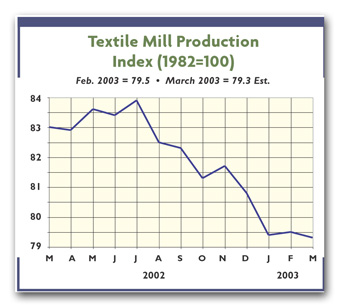S
pinners continue to report strong volume across the board. The ring-spinning market is
very good at the moment and looks good through the first half of this year. One ring spinner said: “
We are running seven days a week and anticipate no slack-off whatsoever through the July 4th
holiday. Beyond that, the third quarter looks pretty good.”
Another spinner with a variety of spinning systems — ring, open-end and air-jet — said: “
Demand is good. We just don’t know how long it will last. We think it is driven by retailers’
inability to borrow against next year’s quota, as they have in the past. The stores are concerned
that they have goods on the shelves.”
Surf’s Up
On the man-made fiber side in particular, spinners are surfing a wave of raw material price
increases. It gets especially difficult when a downstream supplier has committed to prices with the
retailer for an entire season. As one spinner put it: “Price increases are very difficult, and
often they come out of our pocket. Fiber companies are only somewhat sympathetic because some of
them are going through financial difficulties of their own.”
That’s the bad news. The good news is, it appears retailers might be showing signs of
improved tolerance for price increases. One executive said he has read a few articles suggesting
Wal-Mart might be more accepting of price increases that are raw-material-driven.
He cited recent articles in the Wall Street Journal and AdAge. However, spinners are still
waiting to experience this trend firsthand.
On the cotton fiber side, prices seem to have stabilized, but no one is certain where they
are headed. One spinner noted: “The Chinese are the key to it, but nobody seems to know what [the
Chinese] are doing. I think cotton prices will be pretty stable from now until the next crop, but
that’s a guess.”
2005: Several Scenarios
Expectations about the effects of the 2005 World Trade Organization quota phase-out were all
over the parking lot.
One theory is that countries like China have run out of quota, or will run out very shortly.
When they do, they have to stop shipping goods, but may not stop producing them. This could lead to
a tsunami of inventory coming into the US market in early 2005.
One spinner allowed: “The first quarter of 2005 is going to be a little iffy unless we get
sufficient chase business out of the retailers to keep [the Caribbean Basin Initiative] and the
Americas going strong. The big question is what China will do, and how much it will continue to
produce in the last quarter.”
Another saw two possibilities for 2005: “One is that we hit a giant iceberg, and the whole
ship sinks because there is just no business for next year. More likely, there will be continued
erosion of the domestic market, but there will be a domestic market — between niche businesses and
businesses where customers have a better understanding of the local market, or can turn quickly.”
A third spinner was more optimistic. He said: “I don’t know that it will have that much more
of an effect than it already has. We’ve seen a paring down of the business over the last few years,
and I’m not so sure it is going to get much worse. I don’t think business will come to a screeching
halt.”
ATMI, AYSA, NCTO
Opinions also varied about the recent changing of the guard among the textile trade
associations. The American Textile Manufacturers Institute (ATMI) has closed, and the American Yarn
Spinners Association (AYSA) will close this summer. In their place will be the National Council of
Textile Organizations (NCTO).
One spinner was clearly negative: “It is an absolute crying shame AYSA will disappear. I’m
seriously concerned yarn spinners will not have any voice in this new organization.”
Another was more positive: “We are very supportive of that development. It’s better to
formulate one omnibus-type organization that can be more effective in Washington. With the right
lobbying effort and the right coordination among different industry sectors, we can still be
effective as a trade organization with NCTO.”
A third spinner also was fairly upbeat: “One unified voice is probably better than several
smaller ones. ATMI and AYSA both did good things in the past, but our industry now will probably
have more muscle as one group with a united front.”
May 2004







